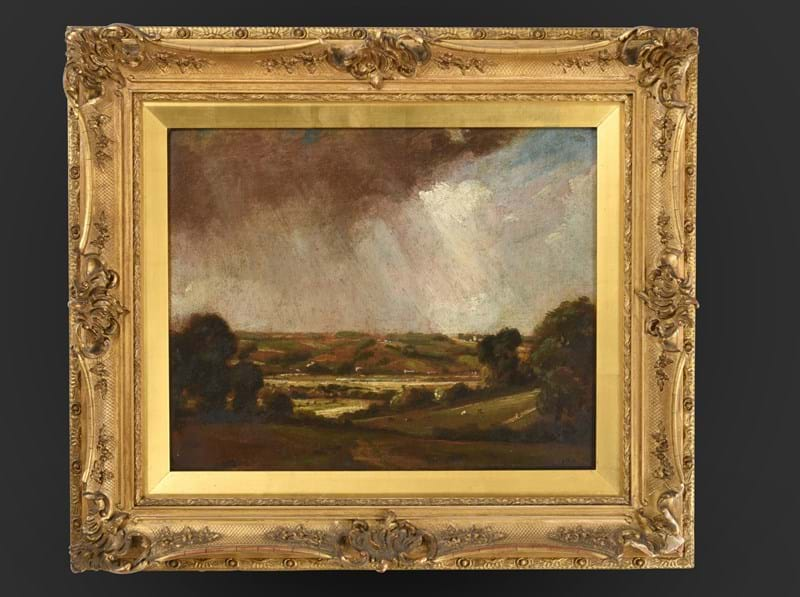A rare architectural work by Dame Eileen Mayo has been re-discovered and will be offered for auction in the Modern & Contemporary Art Sale on 5th October at Tennants Auctioneers. “Circular Quay, Sydney” was executed in 1964, following Mayo’s emigration to the Southern Hemisphere, and will be sold with an estimate of £800-1,200 (plus buyer’s premium).
Dame Eileen Mayo was a multi-talented artist. She was a gifted printmaker, painter, illustrator, designer and author whose long career spanned across the globe from England to Australasia, yet she never lost the primary focus of her creativity - depicting the natural world.
London
Born in Norwich, from a young age Mayo was fascinated by flora and fauna, and as a child was preoccupied with drawing from nature. As a young artist, she began establishing herself in London, having trained at the Slade School of Art, the Central School of Art and Chelsea Polytechnic where she studied under Henry Moore. Her finances were tight, her father having died in 1921, and she supplemented her income teaching at St Martins’ School of Art and by modelling for notable British artists such as Duncan Grant, Dod Procter, Vanessa Bell and Laura Knight. Indeed, one of Knight’s extraordinary portraits of her, “The Maiden”, sold at Tennants in 2015 for £33,000. With such illustrious friends and mentors, Mayo soon made a name for herself, particularly as a print maker, and became a significant part of the British art scene in the 1930s and 1940s. Her first break came in 1928, when her linocut “Turkish Bath” was shown at the Redfern Gallery and purchased by the Victoria and Albert Museum. She would go on to have a long association with the Redfern Gallery, and exhibit at the Royal Academy and at the Leicester Gallery.
A perfectionist, Mayo turned her hand to all manner of materials and techniques, thinking herself as a craftsperson learning a new skill. Whether she was experimenting with tapestry designs, linocuts, wood engravings or paintings, she always focussed on what was beautiful and decorative in nature.
Having married Dr Richard Gainsborough in 1936, Mayo spent the duration of the Second World War helping run her husband’s medical practice in the country and writing and illustrating her first book The Story of Living Things and their Evolution. However, the pair’s divorce in 1952 sparked a major change for the artist.
Australia
Following her father’s death, Mayo’s mother and sister had emigrated to New Zealand, and by the early 1950s her sister was living in Sydney. Suffering with depression following her divorce, Mayo emigrated to Australia, and settled in Sydney to be nearer her family.
Sydney was seeing a revival of interest in printmaking, and Mayo became a key member in the country’s artistic reinvigoration. Here she taught at the National Art School and was a founder member of the Sydney Printmakers. With a pressing need to support herself financially, Mayo made very little work outside of commercial commissions, instead producing a body of work that included an iconic set of poster designs for the Australian National Travel Association, and sets of stamps featuring the country’s birds, animals and plants. All were colourful, decorative and stylised designs for which Mayo had studied her subjects in depth. She also made a vast mural for the Australia Museum depicting underwater life and produced numerous advertisements and designs for textiles.
New Zealand
In 1962 Mayo moved to New Zealand to be with her mother and sister in Waimate, but despite her commercial success, she was not received as a ‘proper’ artist in the country as she was not solely a painter. Mayo herself, in the Arts and Crafts tradition, placed equal value on the applied and fine arts.
Circular Quay, Sydney
As she settled into her new home in New Zealand’s South Island, Mayo worked on a painting, Warehouses, Sydney (1963), based on drawings she had made of the old sandstone warehouses along the eastern side of Sydney Cove that had just been demolished. The painting was later reproduced as a card for the Australian Mutual Provident Society (AMP), whose headquarters were in one of the new modern buildings that sprung up around the quay in the 1960s. According to a record in the National Library, Wellington, Mayo also designed the front cover of the AMP’s 1964 magazine which depicted four warehouses on Circular Quay, which had been demolished to make way for the building of a tower for the British Tobacco Co. (Australia) Ltd.
The present work, “Circular Quay, Sydney” (1964) was sold by the Riverhouse Galleries in Brisbane but its whereabouts was lost, and it was listed in Margaret Jillian Cassidy’s thesis Shifting Boundaries, The Art of Eileen Mayo as location unknown.
Sydney Cove was the site of the landing of the First Fleet in 1788 and was the point from which Sydney grew. The first wharfs were built in 1792, and Circular Quay (originally called Semi-Circular Quay) was constructed between 1837 and 1844 to become the central harbour and port for the city. By the 1860s all sides of the quay were lined with warehouses, largely devoted to the wool trade. As the city outgrew the cove, it was converted to a passenger ferry hub, and from the 1950s the stone warehouses were replaced with modernist buildings and the first skyscrapers in Sydney. AMP’s headquarters were built on the south shore in 1962, and at the time it was Sydney’s tallest building. Sydney Cove was crowned with the building of the Sydney Opera House on the northeast point in the early 1970s.
Later Years
In 1965 Mayo moved to Christchurch, where she would live for the rest of her life, save for a short spell in Dunedin. She taught at the University of Canterbury, and served on the Print Council of New Zealand, all the while producing work that combined her sense of colour harmony, eye for design and in-depth research into her subject. Mayo had devoted her life to art, and continued to work until 1985, when arthritis overcame her, and was made a Dame in 1994 for services to art, just days before her death.
Today, Mayo’s work is once more becoming increasingly sought-after, particularly with the resurgence in popularity of avant-garde female artists and prints artist such as those belonging to the Grosvenor School. A major exhibition of her work was held in 2019 at the Christchurch Art Gallery.













